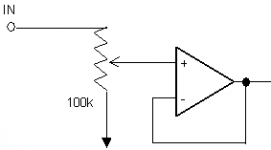My question is about how to select an op amp for the application I have shown in the attached image. Forgive me if this is repetitive or way off in some technical sense.
At first I thought, buffer service, no problem, all the favorites mentioned on the forum can do it: OPA2134, NE5532, LM6172, and so on.
Then there I see in the OPA2134 datasheet a blurb about compensating for the impedance of the source, and if not done properly, introducing distortion.
And then I read in the LM6172 datasheet a warning about overshoot in unity gain applications and a suggestion to put a cap in the feedback loop to eliminate this.
So now I think, is 90% of the iceberg beneath the water?
At first I thought, buffer service, no problem, all the favorites mentioned on the forum can do it: OPA2134, NE5532, LM6172, and so on.
Then there I see in the OPA2134 datasheet a blurb about compensating for the impedance of the source, and if not done properly, introducing distortion.
And then I read in the LM6172 datasheet a warning about overshoot in unity gain applications and a suggestion to put a cap in the feedback loop to eliminate this.
So now I think, is 90% of the iceberg beneath the water?
Attachments
Opamp Buffer
Hi leadbelly ,
The density of ice is 0.9 that of water so your guess may be right.😀
I would replace the short between the inverting input and the output by a 1k resistor. Of course the opamp needs to be unity-gain stable.😎
Hi leadbelly ,
The density of ice is 0.9 that of water so your guess may be right.😀
I would replace the short between the inverting input and the output by a 1k resistor. Of course the opamp needs to be unity-gain stable.😎
- Status
- Not open for further replies.
